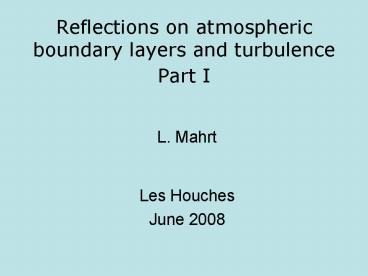Reflections on atmospheric boundary layers and turbulence Part I - PowerPoint PPT Presentation
1 / 22
Title:
Reflections on atmospheric boundary layers and turbulence Part I
Description:
Understanding turbulence in homogeneous stationary ... Interpreting Fourier spectra is tenuous. Generally requires additional procedures to look 'nice' ... – PowerPoint PPT presentation
Number of Views:52
Avg rating:3.0/5.0
Title: Reflections on atmospheric boundary layers and turbulence Part I
1
Reflections on atmospheric boundary layers and
turbulencePart I
- L. Mahrt
- Les Houches
- June 2008
2
- Understanding turbulence in homogeneous
stationary conditions is necessary before
attempting to understand more common situations
where such conditions are not met. - Parallel investigations of more complex realistic
conditions are necessary with the recognition
that scientific rigor will be less. This area has
been neglected.
3
Classical definitions of turbulence
- 1. Three-dimensional vortex stretching
(two-dimensional turbulence is not turbulence). - 2. Random, at least on scales smaller than the
main coherent structures. - 3. Diffusive (in contrast to waves for example).
- 4. Local, not periodic
4
(No Transcript)
5
In the previous diagram, the basis set was not
specified.
- Fourier spectra is the traditional approach,
originally motivated by solutions to linear
equations. However eddies are highly nonlinear
and local and not well represented in Fourier
space (Heisenberg, Tennekes, Leseur).
Interpreting Fourier spectra is tenuous.
Generally requires additional procedures to look
nice. - Wavelet basis sets are local, but numerous
options - Multiresolution satisfies Reynolds averaging, but
basis set is discontinuous. - Since no basis can look like all of the eddies,
there is always scale leakage.
6
The vertical flux
- The vertical flux consists of a molecular part, a
turbulent part and a part due to larger scales
(e.g., mesoscale). - For turbulence studies and evaluation of
similarity theory, include only turbulence part. - For budget studies, require total flux.
- Limiting factors at larger scales
- Random flux error may be much larger than
systematic part - The weak vertical motions on the mesoscale are
difficult to measure even though it may lead to
large flux (large scalar fluctuations).
7
Distinction between mesoscale motions and
transitional hybrid motions
- Nonlinear gravity waves transport momentum
- w decaying -gt gravity waves, vortex modes
- Regeneration/instability stage
- Roll vortices
- Inactive eddies
8
(No Transcript)
9
Similarity theory
- Describe the flow with a limited number of
length, time and velocity scales. - Surface layer scaling based on the heat flux, u
and z.
10
Additional similarity arguments
- Thin boundary-layer depth
- Local advection
- Low-level wind maximum/ Downward transport of
TKE - Roughness sublayer variables
- Strength of the submeso scale motions/nonstationar
ity
11
(No Transcript)
12
The real world
- Heterogeneity simultaneously on multiple scales
- Nonstationary simultaneously on multiple time
scales
13
(No Transcript)
14
(No Transcript)
15
(No Transcript)
16
(No Transcript)
17
From warm to cold
18
(No Transcript)
19
From warm to cold
20
From warm to cold
21
The impact of surface heterogeneity, footprint
theory, blending height, internal boundary layers
- Blending height, if exists, is a scaling depth
- Footprint theory most valid for near neutral
conditions with horizontally homogeneous
turbulence and heterogenous scalar source - Change to smaller roughness and change to
downward heat flux lead to poorly defined
internal boundary layers
22
Conclusions
- 1. Distinction between turbulence and larger
scales is sometimes ambiguous particularly with
weak turbulence Fourier space requires extra
caution. - 2. Even with homogenous stationary conditions,
the near-surface roughness sublayer is not fully
understood. - 3. Existing framework for representing surface
heterogeneity is useful but not applicable to
most surfaces.

